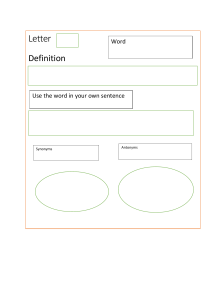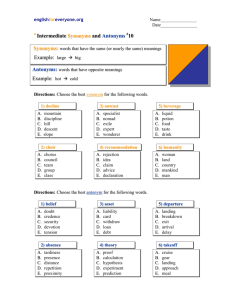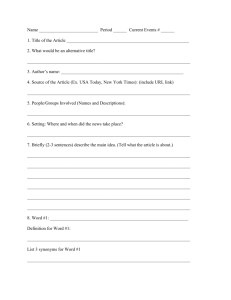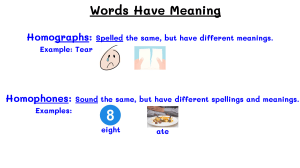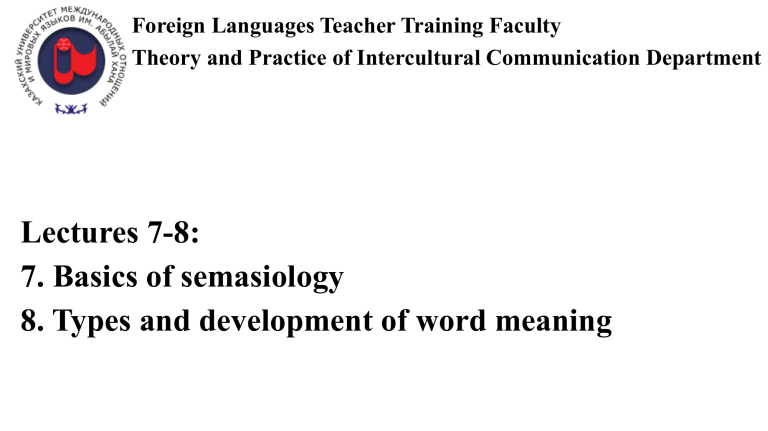
Foreign Languages Teacher Training Faculty Theory and Practice of Intercultural Communication Department Lectures 7-8: 7. Basics of semasiology 8. Types and development of word meaning Seminar tasks 1.Define the importance of semasiology and dwell on the following point: “Teaching semantics helps students develop their vocabulary by introducing them to new words and phrases and helping them understand their meanings. This is important for reading comprehension and writing skills, as it enables students to use a wider range of words and express themselves more accurately and effectively.” Express you opinion and provide examples. 2.Characterize the approaches to word meaning. Describe their features and interconnection. Explain their role for FLT. 3.Analyze the features of referential approach to word meaning. What is the contribution of the notion of reference to the study of word meaning, and why it should not be ignored, even though there are such patent problems with it? 4.Analyze the features of operational approach to word meaning. Define its significance for FLT. 5. Generalize the facts about types of word meaning. Present exercises for your learners, explaining the ways of practicing types of word meaning. 6. Study the following teaching synonyms resource https://www.teachstarter.com/us/learning-area/synonyms/ Prepare a list of arguments in favor of better technique. Reason your preference. 7.Define polysemy as a linguistic phenomenon. Illustrate your answer with examples of adapting polysemy to teaching English. 8.Choose any polysemantic word and illustrate its meanings with examples. Prove that the meanings are related one to another. How can you incorporate this activity to FLT? The Development of Semasiology as a Linguistic Discipline • One way of enriching the vocabulary is semantic changes. Problems of meaning and its changes are studied by semasiology (Greek sëmasia ‘signification’, sêma sign’, sèmantikos ‘significant’). • The main objects of semasiological study are semantic development of words, relevant distinctive features and types of lexical meaning, polysemy and semantic structure of words, semantic grouping and connections in the vocabulary system, i.e., synonyms, antonyms, terminological systems, etc. [Arnold, 1986]. • The two terms, semasiology and semantics, are sometimes used as synonyms referring to the science of meaning. According to Prof. J.R. Firth, the English word for the historical study of change of meaning was semasiology, until the new term semantics was introduced into linguistic studies. Referential approach Tom Functional approach Operational approach Comment on the meanings of the underlined words paying attention to their contextual meaning • He’s been very sweet to his father. kind • He had poor opinion of the process of thought. bad • Stop acting like a bull in a china shop. clumsy person • She had stars in her eyes when she won first prize in the contest. happy Types of word meaning • Grammatical meaning. Grammatical meaning is defined as an expression in speech of relationship between words -the meaning of plurality boys, girls, tables -the tense meaning of the words asked, thought, worked - the case meaning parents’, sister’s, boy’s Two Approaches to the Content Facet Units 1. Semasiological – starts with the name (form) and consists in considering different meanings of the word, determining interrelations between them, as well as discovering semantic relations between different words. 2. Onomasiological – starts from the object and consists in analyzing different words correlated with it. This approach helps to discover how meaning is formed, considering its basic properties and peculiarities. Define the meanings of the words in the following sentences. Say how the meanings of the same word are associated one with another a) I began to search the flat, looking in drawers and boxes to see of I could find a key. b) I tumbled with a sort of splash upon the keys of a ghostly piano. a)Her mouth opened crookedly half an inch, and she shot a few words at one like pebbles. b) Would you like me to come to the mouth of the river with you? a)I sat down for a few minutes with my head in my hands, until I heard the phone taken up inside and the butler’s voice calling a taxi. b)The minute hand of the electric clock jumped on to figure twelve, and, simultaneously, the steeple of St. Mary’s whose vicar always kept his clock by the wireless began its feeble imitation of Big Ben. Arrange the following words into groups of synonyms sharp, to surprise, intelligent, to agree, alone, to shiver, to amaze, to shudder, to approve, to tremble, lonely, to consent, clever, solitary, to astonish. to surprise, to astonish, to amaze alone, lonely, solitary to agree, to consent, to approve to tremble, to shiver, to shudder clever, sharp, intelligent REFERENCES • 1. Лексикология современного английского языка: Учебное пособие / И.В. Арнольд. – М.: Флинта, 2012. – 377с. // • 2. Алефиренко Н.Ф. Теория языка: вводный курс: учеб. пособие для студ, вузов / Н. Ф. Алефиренко. – 4-е изд., стер.. – М.: Академия, 2010. – 384 с. • 3. Бабич Г.Н. Lexicology: A Current Guide. Лексикология английского языка [Электронный ресурс]: Уч. пособ. / Г. Н. Бабич. – 5-е изд. – М.: Флинта: Наука, 2010. – 200 с. • 4. Гвишиани Н. Б. Современный английский язык. Лексикология = Modern English studies. Lexicology: учебное пособие для студентов высших учебных заведений, обучающихся по направлению 031000 и специальности 031001 – Филология: по специальности 033200 (050303) – Иностранный язык / Н. Б. Гвишиани. – 2-е изд., стер.. – М.: Академия, 2009. – 218 с. • 5. Прохорова Н.М. Lecture on English Lexicology: Учебник / Н.М. Прохорова. – Красноярск: РИО КГПУ, 2003. – 208 с. • 6. Metcalf, Allan (2002). Predicting New Words – The Secrets of Their Success. Boston: Houghton Mifflin Company. ISBN 0-618-13006-3. – на англ. яз.


